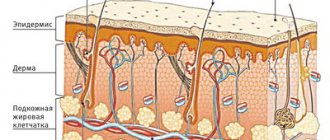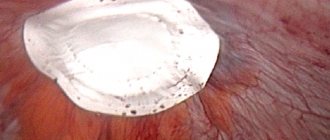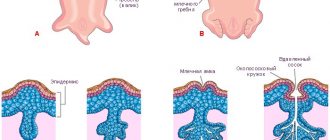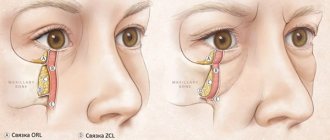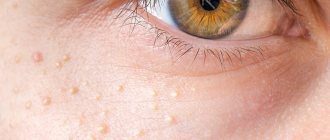Adolescent gynecomastia is an increase in size of the mammary glands due to adipose tissue. As a rule, this type of gynecomastia develops in adolescents aged 14-15 years, but there are cases of the development of this pathology in children 11-12 years old. Moreover, this disease is quite widespread - it occurs in almost 70% of young men. Typically, the enlargement of the mammary glands in adolescents is expressed slightly, in the form of slight swelling of the areola, as well as increased sensitivity of the nipples. Therefore, the help of doctors for this pathology may not be required. Most often, gynecomastia in adolescents goes away completely on its own within about two years. If the pathology persists for a long time, then the child should undergo a special examination, including hormone tests, mammography and ultrasound.
Indications for surgery to remove gynecomastia
In some cases, surgery can help a person cope with gynecomastia and make his life more comfortable
The operation is prescribed to remove excessively overgrown fatty and glandular tissue in the breast. Such an intervention is not the main treatment, but only acts as one of its stages, when treatment with medications does not significantly reduce the male mammary glands.
What may be contraindications for surgery?
Some concomitant pathologies of the patient become a contraindication for surgical intervention to correct gynecomastia. The operation can most often be refused due to:
- the presence of acute chronic infections during exacerbation;
- in cases where the stage of development of gynecomastia is small and there has been no drug treatment yet;
- severe obesity;
- pathologies in which anesthesia can cause great harm to the body or there is a risk of death, etc.
Any surgical intervention must be medically justified and the doctor must give a referral for it. In this case, unnecessary intervention can cause more harm than the disease itself.
Causes
The reasons for the appearance of this pathology may be different. As a rule, gynecomastia in adolescents develops during puberty. In this case, the reason for its appearance is the beginning of the production of a hormone called testosterone, as well as the temporary conversion of testosterone into estrogen, which contributes to an increase in the size of the mammary glands. Having an obese child only exacerbates this problem. After all, it is the excess of extra pounds that promotes the conversion of testosterone into estrogen in fat cells. Also, with obesity, folds on the chest become much more noticeable and stick out under clothes, bringing a lot of distress to the child. Juvenile (adolescent) gynecomastia can also develop as a result of diseases that are accompanied by excessive production of a hormone called estrogen. Such diseases include various liver dysfunctions, chromosomal abnormalities, and testicular tumors. Sometimes gynecomastia in children develops as a result of starvation. Also, the mammary glands can increase in size as a result of injury or due to mechanical irritation. Often the cause of gynecomastia is Reifenstein syndrome, in which there is a defect in the synthesis of testosterone in the body. This is a hereditary disease with a male karyotype, in which from birth the child has virilization of the genital organs, and sometimes cryptorchidism. During adolescence, the child develops gynecomastia and sparse body hair. It is also possible to develop so-called medicinal gynecomastia. Its cause is bodybuilding, as well as the use of anabolic steroids by a teenager. Sometimes gynecomastia occurs due to the child using drugs. If doctors are unable to identify the cause of gynecomastia, then they diagnose “idiopathic gynecomastia.”
Methods for removing gynecomastia
Today, two types of surgery and one correction procedure are used to remove enlarged mammary glands:
- liposuction – removal of excess fat particles;
- complete removal of the mammary gland;
- laser removal.
Liposuction
The essence of this operation for removing gynecomastia is that excess fat in the chest area is removed.
Liposuction is effective for false type of gynecomastia, when fat deposits in the breasts are caused by obesity. Also, this procedure is rather corrective and in order not to repeat it, you must adhere to the recommendations of a specialist in maintaining a healthy lifestyle.
Mastectomy
In men, surgery to eliminate gynecomastia by removing the glandular tissue itself is called a mastectomy. This intervention is recommended for true gynecomastia, when there is a suspicion that a tumor may develop in this area.
After the intervention, a scar remains, which is why some patients refuse this technique. But today, most of these operations are performed using a minimally invasive method, when several incisions are made through which the surgeon works. It is not inferior in effectiveness, and barely noticeable scars remain.
Laser removal
During the operation, glandular tissue is removed, but it is not as effective as a mastectomy and can cause relapses in the future.
During the operation, a puncture is made into which a laser is inserted, which burns off excess glandular tissue.
Symptoms
For a teenager, the presence of gynecomastia can become a serious problem, primarily of a psychological nature. After all, instead of maturing, the young man’s breasts begin to grow. Moreover, in 80% of cases, both mammary glands enlarge, which significantly aggravates the problem. Gynecomastia in boys often leads to them avoiding sports and swimming. Because the nipples may be sore, the baby may experience discomfort. The skin in the area of the mammary glands is usually not changed. Sometimes there is a retracted nipple; almost always it is somewhat enlarged in size, its areola is pigmented and slightly expanded.
Preparing for surgery
Your attending physician will tell you in detail about preparing for surgery to eliminate gynecomastia. We will touch on the main aspects of this period.
Since the operation is performed under general anesthesia, before the operation the patient will need to collect a lot of research so that during the operation the specialists know what is happening to the patient, know what drugs can be used, etc. The preoperative examination necessarily includes a general blood test, a blood test for hormones, a urine test, directions will be given to investigate the presence of infections in the body, you will have to undergo an ECG, fluorography, ultrasound of the abdominal cavity, ultrasound of the mammary glands and adjacent lymph nodes.
Please note that the examination data has a deadline, that is, it must be done before the operation, usually no earlier than two weeks.
In case of parallel pathologies, before correction of gynecomastia, the patient will be referred for consultation to specialized specialists to obtain their opinion.
Immediately before the operation, a man must follow several rules:
- exclude the consumption of alcoholic beverages;
- eliminate cigarettes or reduce their quantity as much as possible;
- A few days before surgery, it is better not to load your stomach with complex fatty foods.
Gynecomastia in adolescence
"Wait until you're 18..."
As a rule, parents of such children turn to an endocrinologist and are advised to wait indefinitely. This statement is paradoxical. If gynecomastia does not go away on its own within six months after its occurrence, it can no longer disappear. The growth of the rudimentary mammary gland is controlled by hormones, and it is estrogens that are responsible for this process. Figuratively speaking, the mammary glands do not care in which body they exist - male or female. They will behave as their hormones tell them to. That is, despite the fact that gynecomastia is a pathology in the male body, the growth of the mammary glands is a natural phenomenon in the event of an increase in estrogen levels. The formed mammary gland is essentially an organ that cannot disappear anywhere.
In our practice, there have been cases when desperate young people sought surgical help immediately after reaching adulthood due to a lack of mutual understanding with their parents, who were afraid to have surgery or hoped that gynecomastia would disappear.
Recovery after removal of gynecomastia in men
After the operation, you need to wear a special compression bandage for some time, which will prevent the appearance of unwanted stretch marks, fix the chest, and allow you to recover faster after the operation.
Medicines are used in some cases, if the patient suffers from pain in the chest, then analgesics and some types of anti-inflammatory drugs can be used.
In case of complications, the doctor will prescribe special medications depending on the situation and the complications that have occurred. By the way, surgery to remove gynecomastia in men has an extremely low percentage of complications.
For faster healing, ointments that promote regeneration can be prescribed. After removing the bandage, it is recommended to bandage the chest with an elastic bandage for 14-21 days. Sutures are removed 10-14 days after surgery.
During the recovery period, you need to eat well, and most importantly, the diet should be balanced; vitamin and mineral complexes may be prescribed.
It is strictly forbidden to begin physical activity for 30-40 days after an operation has been performed without subsequent complications.
Rehabilitation period
To reduce the risk of complications after surgery, it is recommended to follow some rules:
- Follow your doctor's orders. The doctor may prescribe a course of antibacterial or anti-inflammatory drugs. And to reduce the intensity of postoperative pain - painkillers.
- Until complete recovery, it is recommended to avoid increased physical activity.
- You must constantly wear compression garments; the degree of compression is determined individually.
- It is necessary to avoid going to the bathhouse, sauna and swimming pool until complete recovery.
In just 5-7 days you can return to your normal rhythm of life, and after a month you can play sports again and enjoy your new body. The final result can be assessed after 3 months.
You can find out more detailed information about surgery for gynecomastia during an in-person consultation with a specialist. Be healthy!
Which specialist should I contact if I suspect gynecomastia?
Surgery is the final treatment for gynecomastia in men. Before this, it is necessary to undergo treatment that would stop the underlying disorder that caused this condition. To correctly find the cause and carry out effective treatment, you need to contact a qualified specialist.
I, Georgy Nikitich Romanov, received an education as an endocrinologist and have been working in my profession for more than 20 years. The cause of the development of gynecomastia is hormonal imbalance or endocrine pathologies, the treatment of which I have been treating for a long time and successfully, therefore, before removing gynecomastia, patients turn to me for help.
I conduct appointments at the medical center, and you can also sign up for a paid online consultation with me. As part of this service, I can make treatment adjustments, prescribe tests based on existing symptoms, make a diagnosis based on the studies, and monitor the treatment process.
You can sign up for a consultation in any of the presented messengers: Viber, Telegram, Instagram, WhatsApp, Skype, Vkontakte.
Basic treatment for gynecomastia
If signs indicating the presence of a disease appear, you should visit a doctor. The specialist must determine the cause of gynecomastia and recommend treatment based on the existing symptoms, stage and form of the disease. After the examination, the specialist sends the patient for blood tests. If the cause of gynecomastia is hidden at the hormonal level, there is a violation of the amount and ratio of hormones in the blood. An ultrasound of the mammary glands is required. CT, MRI and other x-ray examinations are usually not required.
Based on the results, treatment is prescribed.
Rice. 2 Gynecomastia, severe manifestations. Hormone treatment did not work
To normalize hormonal levels (decreasing the level of the female sex hormone - estrogen and increasing the level of the male sex hormone - testosterone), medications are prescribed. They can work in two ways: suppress estrogen levels or increase testosterone production. Drug therapy must be started as soon as possible, since gynecomastia can be cured with medication only at the initial stage.
Remember this and hurry to the doctor!
Of course, most men do not like to visit medical institutions. But delay in this matter will lead to a missed opportunity to get rid of the disease without surgery. With hormonal therapy for gynecomastia started in a timely manner, the symptoms go away, the breasts shrink to normal in the first months from the start of treatment. However, if there is no result after six months, surgery is recommended.
Rice. 3 Laser treatment. Gynecomastia with complete cure
conclusions
Surgery to remove gynecomastia is most often resorted to for aesthetic reasons, because after the course of treatment, the breasts may not recover to their previous position and many men are embarrassed by this, then the solution is surgical intervention. But it is worth remembering that sometimes this intervention is vital, since breast cancer may develop in the future.
In general, surgery to remove gynecomastia is simple, and the recovery period is not too long.


